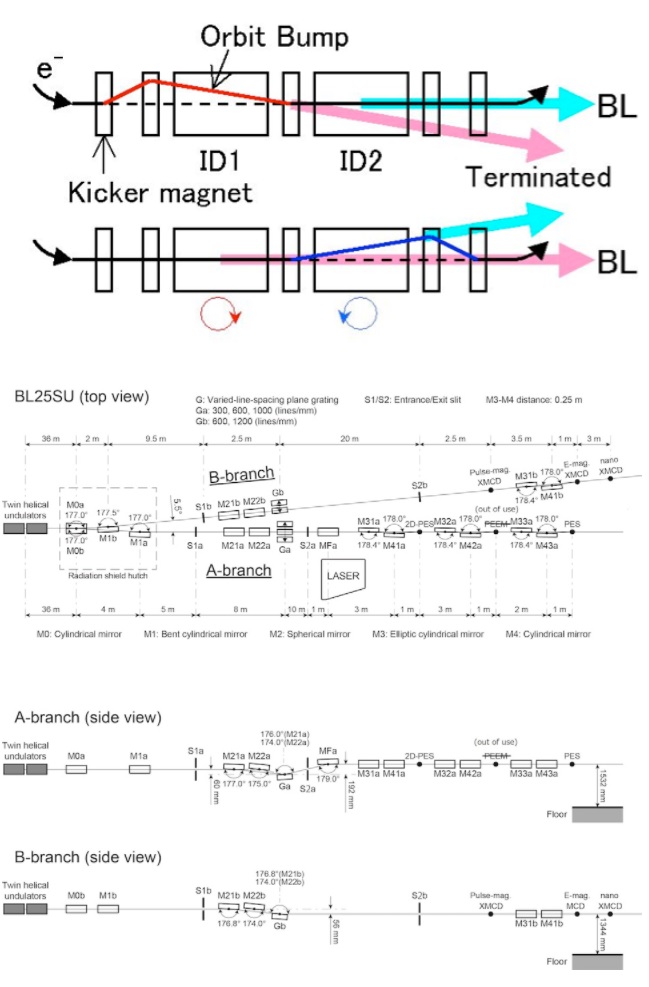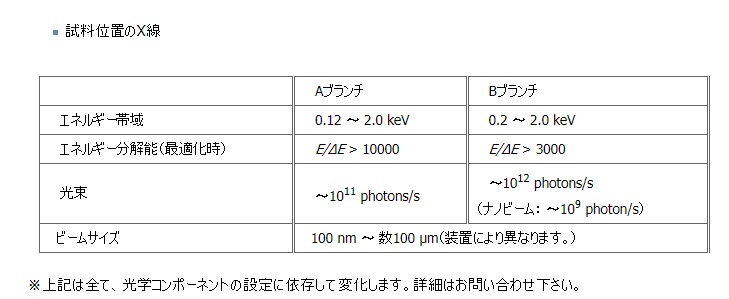BL25SU
◆ビームラインの概要
BL25SUは固体物質の電子状態や磁気状態、さらに、表面構造などを円偏光軟X線によって解明することを目的としています。光源であるツインヘリカルアンジュレーターは、2台のヘリカルアンジュレーター(それぞれ、長さ1.5 m)で構成され、左回り、または右回り円偏光軟X線を選択して生成します。円偏光のヘリシティーは、キッカーシステムによって周期条件での切り替えが可能であり、0.1、1、10 Hzの3種のモードが使用できます。ビームラインは、Aブランチ(マイクロビームブランチ)とBブランチ(ナノビームブランチ)で構成されます。A、B各ブランチは、前置鏡の切り替えによりタイムシェア利用となっています。AブランチではE/ΔE > 10000 @1 keVの高分解能の軟X線(0.12〜2 keV)が利用でき、エンドステーションには、二次元表示型光電子アナライザー(2D-PES)、光電子分光(PES)装置が配置されています。一方、Bブランチ(ナノビームブランチ)におけるエネルギー分解能(E/ΔE > 3000)はAブランチに比べて劣りますが、その代わりに高フラックスの軟X線(0.2〜2 keV)が利用できます。BブランチにはX線磁気円二色性(XMCD)装置が設置されています。Bブランチ最下流のナノビームXMCD装置は、元素戦略プロジェクト(研究拠点形成型)<磁性材料研究拠点>により導入されました。ナノビームXMCD装置では、フレネルゾーンプレート(FZP)により集光されたφ100 nm以下のナノビームを利用します。試料空間の真空度は実験装置により異なりますが、原則として超高真空下(10-8 〜 10-7 Pa台)で行われます。なお、本ビームラインでは放射性物質および活性ガスを用いた実験はできません。
※主に光電子分光実験で利用する特定の偏光モード(右円偏光+右円偏光)に対応できない場合があります。
詳しくはBL担当者にお問い合わせください。
<用語>
・阻止電場型分析器 (Retarding field analyser, RFA)
・光電子分光 (Photoemission electron spectroscopy, PES)
・X線磁気円二色性 (X-ray magnetic circular dichroism, XMCD)
・フレネルゾーンプレート (Fresnel zone plate, FZP)
・光電子回折 (Photoelectron diffraction, PED)
・ツインヘリカルアンジュレーター (Twin helical undulators, THU)
・挿入光源(アンジュレーター) (Insertion device, ID)
◆研究分野
<Aブランチ>
・光電子分光(PES)、角度分解光電子分光(ARPES)による電子状態・バンド構造の研究
・光電子回折(PED)による表面原子配列の解析
<Bブランチ>
・X線磁気円二色性(XMCD)による元素選択磁気状態の研究、ナノビームを利用した磁気状態解析
◆光源と光学系
【光源】
ツインヘリカルアンジュレーター(THU) は、円偏光反転のために設計されています。THU は、2台のヘリカルアンジュレーターと、これらのアンジュレーター位置でバンプ電子軌道を形成するための5台のキッカー電磁石で構成されています。バンプ軌道を第一アンジュレーター(ID1)で形成する場合, ID1で発生する放射光は軸外に放出され、第二アンジュレーター(ID2)からの放射光のみが排他的にビームラインに導かれます。ヘリシティはバンプ軌道をID1とID2、それぞれの位置に切り替えることによって反転できます。スイッチングは0.1Hz(台形波)、1Hz(台形波)、10Hz(正弦波)の3種類の周期モードで利用できます。ヘリシティー切り替えは磁気円二色性実験、光電子回折実験などで多く利用されています。
【ビームライン】
光学ハッチ内の最上流にある縦集光ミラー(M0a、M0b)のステージを移動することで、A・Bの各ブランチに排他選択的に光が導かれます。メカニカルベントミラー(M1)で横集光されたのち、球面鏡(M21, M22)と不等間隔刻線回折格子(G)を用いて分光されます。M2とGの組み合わせにより実験目的に合ったエネルギー帯域、エネルギー分解能およびビームフラックスを選択できます。Aブランチでは主に高エネルギー分解能(E/ΔE >10000)、Bブランチでは主に高フラックス(〜1012 photons/sec)を狙った設計となっています。Aブランチでは水平化ミラー(MFa)、Bブランチでは不等間隔刻線回折格子(Gb)から出射されたビームは水平に保たれます(Aブランチ: 地上より約1532 mm、Bブランチ: 〜1344 mm)。各実験装置の上流に設置された専用の後置集光ミラー(M31〜33, M41〜43)でビームが集光されます。Aブランチは上流から2D-PES、PES装置が設置されています。BブランチはXMCD実験のためのブランチで、上流からパルス強磁場軟X線MCD装置、電磁石式軟X線MCD装置、走査型軟X線MCD顕微装置が設置されています。ビームサイズは、Aブランチでは10〜100µm程度、走査型軟X線MCD顕微装置を除くBブランチの装置では数10〜数100 µm、走査型軟X線MCD顕微装置ではFZPを用いてφ100 nm以下に集光されます(ビームサイズは、光学コンポーネントの設定に依存して変化します)。 レーザーブースから供給されるパルスレーザー(Ti: Sapphire (λ=800 nm)、84 MHz, 70 fs-width, (再生増幅器使用時は5 kHz, 120 fs-width))を利用希望の場合は詳細をご相談下さい。
※注.図では、A, B各ブランチの光学コンポーネントであることを添字a, bを付記して示しています。M21, M22, G, M31〜33, M41〜43およびスリット(S1, S2)についても同様です。


◆問い合わせ先
(注)e-mailアドレスは@マーク以下を省略していますので、アカウントの後に@spring8.or.jpを付けてください。
小谷 佳範
(公財)高輝度光科学研究センター(JASRI)
〒679-5198 兵庫県佐用郡佐用町光都1丁目1-1
Phone : 0791-58-0833
Fax : 0791-58-0830
e-mail : ykotani
室 隆桂之
(公財)高輝度光科学研究センター(JASRI)
〒679-5198 兵庫県佐用郡佐用町光都1丁目1-1
Phone : 0791-58-0833
FAX : 0791-58-0830
e-mail : muro
大河内 拓雄
(公財)高輝度光科学研究センター(JASRI)
〒679-5198 兵庫県佐用郡佐用町光都1丁目1-1
Phone : 0791-58-0833
Fax : 0791-58-0830
e-mail : o-taku
大沢 仁志
(公財)高輝度光科学研究センター(JASRI)
〒679-5198 兵庫県佐用郡佐用町光都1丁目1-1
Phone : 0791-58-0833
FAX : 0791-58-0830
e-mail : hitoshio
BL25SU
◆Outline of beamline
The BL25SU has two branched beamlines, called the micro-beam branch (branch A) and the nano-beam branch (branch B), respectively. The nano-beam branch is mainly dedicated for the Elements Strategy Initiative project of Ministry of Education, Culture, Sports, Science and Technology, but is partly used for other experiments.
The BL25SU beamline is designed for research elucidating electronic and magnetic states, and the surface structure of solids. The light source is twin-helical undulators composed of a pair of helical undulators (1.5 m-length for each) which selectively produce right- or left-hand circularly polarized soft X-ray beams. The helicity of the circular polarization can be switched periodically (0.1, 1 and 10 Hz modes are available now), using a kicker magnet system. Either branch A or branch B is used at any one time by switching pre-focusing mirrors. In the A-branch, Retarding field analyzer (RFA) and a photoemission electron spectroscopy (PES) device are located at the end-station, and high energy resolution (E/ΔE > 10000@1 keV) soft X-rays in the range 0.12~2 keV can be used. In B-branch, on the other hand, high flux beams (0.2 ~ 2 keV, 1012photons/s, E/ΔE > 3000@1 keV) are utilized for the X-ray magnetic circular dichroism (XMCD) measurements. The nano-beam XMCD apparatus is newly installed at the end-station of B-branch, where the Elements Strategy Initiative Center for Magnetic Materials (ESICMM) project is conducted. At the nano-beam XMCD apparatus, the soft X-ray beam is focused to < φ100 nm using a Fresnel Zone Plate lens. All the experiments are performed under ultra-high vacuum (10-8 ~ 10-7 Pa) conditions. Radioisotope (RI) elements and reactive gases cannot be used in this beamline.
IMPORTANT
Due to a trouble in the twin helical undulators, either of the undulators is temporally operated until the repairment is completed. Ask the beamline scientist for details.
◆Research field
A-branch
・Research on electronic states and band structures by photoemission spectroscopy (PES) and angle-resolved photoemission spectroscopy (ARPES)
・Analysis of atomic arrangements by photoelectron diffraction (PED)
B-branch
・Research on element-specific magnetic states by X-ray magnetic circular dichroism (XMCD), analysis of magnetic states using soft X-ray nano-beam
◆Light source and optical system
・Light Source
The light source “twin helical undulators (THU)” is designed for helicity switching of circularly polarized X-rays. THU consists of two helical undulators and five kicker magnets. The kicker magnets are used to generate bumped electron orbits at the undulators. For
example, when a bump orbit is formed at the first undulator (ID1, ID: insertion device), the synchrotron radiation (SR) generated at ID1 is deflected out of axis and that at ID2 is exclusively introduced to the beamline. The helicity of the circular polarization can promptly be switched by changing the generating position of the bump orbit between ID1 and 2. Three periodical switching modes, 0.1 Hz (trapezoidal waves), 1 Hz (trapezoidal waves) and 10 Hz (sine waves), are available in this beamline. This helicity switching system is often utilized in PED and XMCD.
・Beamline
The synchrotron light is exclusively introduced to either A- or B-branch at the uppermost stream in a shielded optics hutch, by moving a mirror stage equipped with vertical focusing mirrors (M0a, M0b).
The synchrotron light is horizontally focused by a mechanical bent mirror (M1*) and then monochromatized by a spherical mirror (M21 or M22) and a varied-line-spacing plane grating (G). According to the experimental purpose, the available energy range can be selected by choosing the particular combination of M2 and G. The entire optics is designed to obtain high energy resolution (E/ΔE> 10000@1 keV) in the A-branch and high photon flux (〜1012 photons/sec) in the B-branch. The synchrotron light beam is kept horizontal (A-branch: ~1532 mm-height, B-branch: ~1344 mm) after being extracted from a planation mirror (MFa, A-branch) or the grating (Gb, B-branch). The beam is refocused by post-focusing mirrors (M31~33 and M41~43) installed just in front of each apparatus. In the A-branch, RFA and PES apparatuses are installed. The B-branch is aimed at the research using XMCD and pulse-magnet XMCD, electro-magnet XMCD and nano-XMCD. Typical beam sizes on the experimental samples are ten 〜 one-hundred microns in the A-branch, several-ten 〜 -hundred microns in the B-branch (except for the nano-XMCD station). In the nano-XMCD station, the beam is focused down to <φ100 nm, using a Fresnel zone plate. (Note that the beam sizes may vary depending on settings of the optical components).
* In the figure below, an index “a” or “b” is added for the names of optical components to show the belonging beam branch.


◆Contact
*For e-mail addresses, add "@spring8.or.jp." after the accounts.
Yoshinori KOTANI
SPring-8 / JASRI
1-1-1 Kouto, Sayo-cho, Sayo-gun, Hyogo 679-5198
Phone : +81-(0)791-58-0833
Fax : +81-(0)791-58-0830
e-mail : ykotani
Takayuki MURO
SPring-8 / JASRI
1-1-1 Kouto, Sayo-cho, Sayo-gun, Hyogo 679-5198
Phone : +81-(0)791-58-0833
Fax : +81-(0)791-58-0830
e-mail : muro
Takuo OHKOCHI
SPring-8 / JASRI
1-1-1 Kouto, Sayo-cho, Sayo-gun, Hyogo 679-5198
Phone : +81-(0)791-58-0833
Fax : +81-(0)791-58-0830
e-mail : o-taku
Hitoshi OSAWA
SPring-8 / JASRI
1-1-1 Kouto, Sayo-cho, Sayo-gun, Hyogo 679-5198
Phone : +81-(0)791-58-0833
Fax : +81-(0)791-58-0830
e-mail : hitoshio
